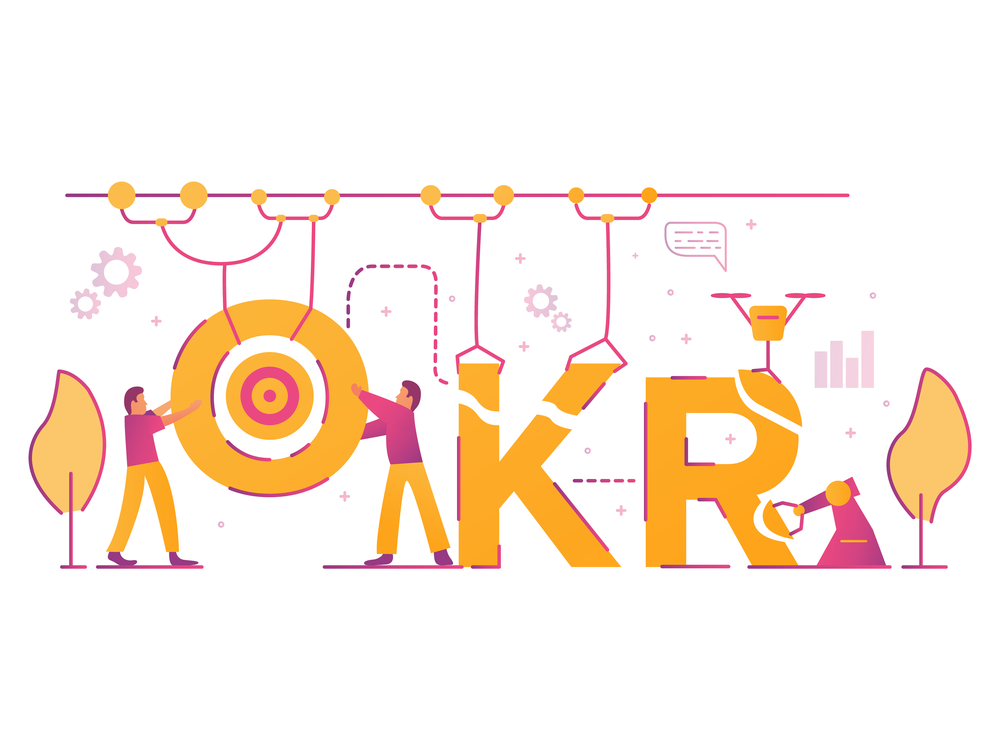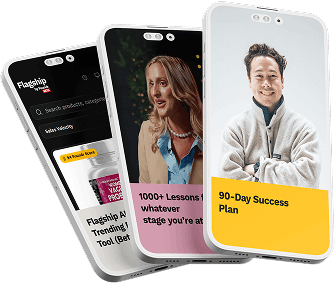Tell us if this sounds familiar. You and your team work hard (day in and day out) to advance the business, but it feels like you’re just spinning tires without going anywhere.
We hear you. You’re not alone.
Only 5% of small business owners achieved all of their goals in 2019. You could blame that on poor goal-setting or bad execution—either or both might be true. However, the more eye-opening statistic is that only 15% of small businesses (SMBs) recorded their full plans for the year, and 27% didn’t document any business strategies.
It’s hard to grow your business if you don’t know where you’re going or have a plan to get there.
That’s where objectives and key results (OKR) come in. Haven’t heard of it before? Join the club. Just 29% of the adult US workforce is familiar with the term.
OKR is a goal-setting framework that big-name companies like Google, Intel, Spotify, and Amazon use to pursue (and accomplish) ambitious goals. We even use it at Foundr (so it must be legit).
It can be an intimidating method for some individuals, so we decided to break down everything you need to know in this guide to OKRs. Below, we’ll explain more about what an OKR is (and isn’t), the differences between OKRs vs. KPIs, the pros and cons of OKRs, OKR examples, and best practices for setting your own.
What Is OKR? Definition and Meaning
The OKR acronym stands for “Objectives and Key Results.” It’s a method of goal-setting that communicates what you want to accomplish and how you’re going to track and measure success.
Andy Grove is credited with creating the OKR framework. Grove brought the goal-setting strategy to Intel and then taught it at seminars—one of which John Doerr attended. John Doerr went on to present the philosophy to Google’s founder in 1999, and since then, many other prominent companies have jumped on board.
The OKR formula is typically an objective and what key results you’ll use to measure success:
- Objective: Describe what you want to achieve as concisely as possible. Make it concrete and actionable. If it can’t be backed up with key results, it’s not a good objective. For example, an objective to “improve company culture” is difficult to measure. How will you know if you’re successful? However, an objective to “reduce employee turnover” can be tracked. You’ll know you’re successful if you decrease the number of employees who quit.
- Key Results: Establish the metrics you’ll use to monitor success. Your key results should be measurable (preferably in real-time) and make it clear whether you’ve achieved your objective. They should be specific, time-bound, and realistic. Back to the employee turnover objective, we might set key results such as “have no more than 5 employees leave,” “reduce the turnover rate by December 31, 2022,” or “lose 0 new employees hired in the last 12 months.”
Types of OKRs
There’s no hard-and-fast rule to setting OKRs—it’s more a guiding framework. However, 3 main types of OKRS can guide you in your goal-setting:
- Committed: Committed OKRs should be accomplished. You know what you need to get done, and you know how to get there—now it’s time to lay out the plan, execute, and make it happen.
- Aspirational: Aspirational OKRs closely resemble “Big Hairy Audacious Goals” (BHAGs). They’re ambitious stretch goals that are insanely hard to achieve but provide a guiding framework for what you want to accomplish in the long term. For example, NASA set a BHAG to land a man on the moon and return him safely—that was crazy thinking at the time.
- Learning: Want to accomplish an objective but not sure how you’re going to measure it? Set a learning OKR. Learning OKRs define what you want to get out of the project. What do you hope to learn or gain?
OKR vs. KPI: What’s the Difference?
OKRs and “Key Performance Indicators” (KPIs) share a lot in common, but they’re not quite the same. KPIs are metrics you want to achieve, but they don’t tell you how to get there.
For example, your content marketing team might have a KPI to “Reach 400K organic visitors.” This number is a good measure of performance, but it doesn’t tell you what needs to be changed to make it happen.
That same KPI in OKR form would look something like this:
Objective: Boost organic traffic to the website
Key Results 1: Drive 400K total unique visitors to the website by end of the year
Key Results 2: Rank on page 1 for 100 new high-volume keywords.
Key Results 3: Increase social media traffic to the website by 15%
OKR Goal-Setting: Pros and Cons
The OKR framework has its ups and downs. Some regard it as a game-changing tactic, while others see it as a waste of time. There’s not a lot of data to back it (or knock it), so you’ll need to review the pros and cons to determine if it’s right for you:
Pros of OKRs
There’s a reason so many successful businesses use OKRs—they work. Here are some of the reasons you might want to consider using OKRs for your business:
- Collaborative Goal Setting: With OKRs, individuals get to set their own objectives and measures of success rather than just blindly attacking a corporate KPI. For example, if the business wants to grow revenue by 30% year-over-year (YoY), that might not impact your day-to-day life in human resources (HR) very much. However, a supporting OKR, such as “Hire top-notch tech sales representatives” and supporting key results would.
- Accountability: OKRs give everyone (individuals, teams, departments, and the organization as a whole) clear, trackable goals to work towards. You know whether you hit the mark or missed the ball when it comes time to report on progress.
- Prioritization: It’s easy to get lost chasing every new shiny object. There are new marketing tactics to try, products to release, and events to host. However, not every work-related activity is a good use of your time. OKRs keep you focused and pushing towards your goals rather than jumping on every bandwagon that rolls along.
Cons of OKRs
The OKR framework is far from perfect. It’s not going to be the best goal-setting methodology for every business. Here are a few of the downsides to OKRs:
- Upfront Investment: Most people don’t know how OKRs work, and they’re not something you can implement and run with if everyone’s not on board. You’ll have to spend valuable time training leadership—and you’ll need to teach them well enough that they can train their direct reports.
- Rigidity: While OKRs can (and should) change over time, they frequently get in the way of pivots and agility. At an enterprise, things move slowly, and you can expect your priorities at the beginning of the year to be the same at the end. That’s not the case for small businesses and rapidly growing startups. When priorities shift, it can be a huge waste to throw your OKRs out the door, especially when you spent (or should have spent) a significant amount of time establishing them.
Best Practices for Developing a Worthwhile OKR
Creating goals that inspire your teams isn’t easy. Just because you adopt OKRs doesn’t mean you’ll get it perfect from the get-go. There’s an art to goal setting that takes time to learn.
Here are a few best practices to keep in mind when creating OKRs:
- Ditch Cascading Objectives: With cascading objectives, you set your organization goals first. Next, departments will set supporting OKRs. Then, teams and individuals. This methodology is supposed to help individuals see how they contribute to the business’s overall goals. For example, if the business sets a goal to “retain customers,” the accounting department establishes an OKR to “maintain accurate customer records,” and your bookkeeper establishes an OKR to “send invoices on time, every time.” However, cascading OKRs usually waste time, and the goals don’t end up aligning. There’s a constant back-and-forth of leaders looking down and individuals looking up rather than team’s taking initiative to tackle the priorities they recognize.
- Keep It Simple: Too many objectives will muddle your priorities and make it difficult to achieve anything. Prioritize a handful of objectives, and focus your time on meeting your key results. Spread yourself too thin, and you likely will fail to meet any of your OKRs. OKRs aren’t meant to cover every aspect of your business—they’re intended to guide how you spend your time and energy.
- Always Include Units of Measurement: If your key results can’t be measured, you won’t know whether you reached a goal or fell short. Find quantifiable ways to measure your progress. OKRs should be full of numbers, dates, and dollar signs.
3 Real-World OKR Examples
Ready to see OKRs in action? Let’s look at how a few well-known companies have used OKRs to scale their business and become household names.
1. Amazon
Jeff Bezos (founder of Amazon) used OKRs to keep Amazon on track to becoming the world’s largest retailer. Instead of focusing on what was going to change, Bezos zeroed in on what wasn’t going to change:
[I]n our retail business, we know that customers want low prices, and I know that’s going to be true 10 years from now. They want fast delivery; they want vast selection. It’s impossible to imagine a future 10 years from now where a customer comes up and says, ‘Jeff, I love Amazon; I just wish the prices were a little higher.’ ‘I love Amazon; I just wish you’d deliver a little more slowly.’ Impossible.
Understanding this truth helped Bezos and his team set long-term goals for the company. They needed more products, lower prices, and faster delivery—that was never going to change. With a clear direction, the company invested in the right systems, infrastructure, and technology.
2. Google
When Jeff Doerr presented the idea of OKRs to Google, he explained it with a basic formula:
I will (Objective) as measured by (this set of Key Results).
Google was responsible for filling in the objective and measurable key results. Marissa Mayer, former vice president at Google, said: “If it does not have a number, it is not a Key Result.”
Google favored bidirectional goal setting where the objectives were influenced bottom-up and top-down. The company didn’t like traditional cascading models.
“Having goals improves performance. Spending hours cascading goals up and down the company, however, does not. It takes way too much time and it’s too hard to make sure all the goals line up,” said Laszlo Bock, Googe’s former VP of People Operations.
3. Allbirds
Allbirds’ co-founder and chief operating office, Joey Zwillinger, is a big fan of OKRs. “Keeping a super clear mission allows our strategies to be consistent and allows our OKRs to connect to them,” Zwillinger says.
Allbirds made sustainability a priority and began sourcing natural products for its apparel. They set an objective for each pair of shoes to have a carbon-neutral footprint. However, to have a carbon-neutral footprint, the company needs to understand how to track carbon emissions in the process (manufacturing, finished products, transportation).
Once the company knows its carbon footprint, it can purchase carbon offsets to reach the carbon-neutral objective. “Every year, we have lower and lower carbon emissions per pair, so that we have to offset less and less, and we connect that through OKRs into financial success as well as impact towards the mission.”
Evolve Your Business to Run Better Without You
Your goal shouldn’t be to micro-manage your business’s way to success. As a leader, you should set up systems that allow your business to run on autopilot.
That’s easier said than done, which is why we built an entire course on how to turn an “owner reliant” business into one that runs even better without you. If you’re feeling burnt out as a leader or entrepreneur, this free course is for you.
You’ll learn:
- The blueprint for building time-saving systems
- The step-by-step process for transforming your business into a systems-driven machine
- How to use and identify the 80/20 processes in your business
- How to gain more freedom, time, and control while growing your business
Ready to ditch the baggage that’s holding your business down? Sign up for the free course today.



















